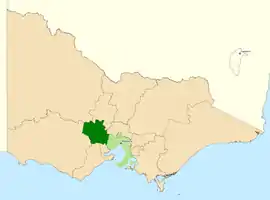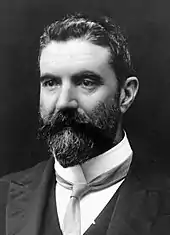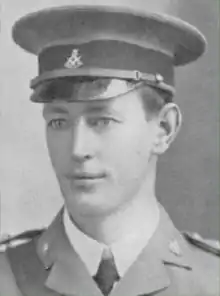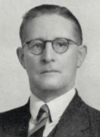Division of Ballarat
The Division of Ballarat (spelt Ballaarat from 1901 until the 1977 election[1]) is an Australian electoral division in the state of Victoria. The division was proclaimed in 1900, and was one of the original 65 divisions to be contested at the first federal election.[1] It was named for the provincial city of the same name by Scottish squatter Archibald Yuille, who established the first settlement − his sheep run called Ballaarat − in 1837,[2] with the name derived from a local Wathawurrung word for the area, balla arat, thought to mean "resting place".
| Ballarat Australian House of Representatives Division | |
|---|---|
 Division of Ballarat in Victoria, as of the 2019 federal election. | |
| Created | 1901 |
| MP | Catherine King |
| Party | Labor |
| Namesake | Ballarat (historically spelled "Ballaarat", from a Wathaurong Aboriginal word: balla arat, thought to mean "resting place".)[1] |
| Electors | 114,981 (2019) |
| Area | 4,322 km2 (1,668.7 sq mi) |
| Demographic | Provincial |
The division currently takes in the regional City of Ballarat and the smaller towns of Bacchus Marsh, Ballan, Blackwood, Buninyong, Clunes, Creswick, Daylesford, Myrniong and Trentham and part of Burrumbeet.
The current Member for Ballarat, since the 2001 federal election, is Catherine King, a member of the Australian Labor Party.
History

At various times in its existence the division has included other towns such as Ararat, Maryborough, and Stawell.
Ballarat used to be a marginal seat, changing hands at intervals between the Labor Party and the non-Labor parties. Unlike most marginal seats, it was not a barometer for winning government; since 1955, all but one of its members has spent at least one term in opposition.
Its most prominent member has been Alfred Deakin, who was Prime Minister of Australia three times. Liberal senator Michael Ronaldson was the grandson of Archibald Fisken, a former Member for Ballarat.[3]
Ballarat also holds the distinction of seeing the closest seat result in Australian history. Nationalist Edwin Kerby unseated Labor incumbent Charles McGrath by a single vote in 1919. However, McGrath alleged irregularities, and the result was thrown out in 1920, forcing a by-election that was won by McGrath.[4]
Since 2001, the seat has been held by Catherine King, a member of the Australian Labor Party. It has been a safe Labor seat since 2007 except for a 6.8 percent swing towards the Liberal Party at the 2013 election turning it marginal for one term.
Members
Election results
| Party | Candidate | Votes | % | ±% | |
|---|---|---|---|---|---|
| Labor | Catherine King | 49,077 | 47.79 | +4.50 | |
| Liberal | Tim Vo | 31,462 | 30.64 | −4.05 | |
| Greens | Karen McAloon | 9,077 | 8.84 | −2.01 | |
| United Australia | Peter Cozyn | 4,741 | 4.62 | +4.62 | |
| Animal Justice | Bryn Hills | 4,393 | 4.28 | +4.28 | |
| Independent | Nick Shady | 2,288 | 2.23 | +2.23 | |
| Independent | Alex Graham | 1,645 | 1.60 | +1.60 | |
| Total formal votes | 102,683 | 95.63 | +0.92 | ||
| Informal votes | 4,689 | 4.37 | −0.92 | ||
| Turnout | 107,372 | 93.40 | +1.03 | ||
| Two-party-preferred result | |||||
| Labor | Catherine King | 62,615 | 60.98 | +3.62 | |
| Liberal | Tim Vo | 40,068 | 39.02 | −3.62 | |
| Labor hold | Swing | +3.62 | |||
References
- "Profile of the electoral division of Ballarat (Vic)". Current federal electoral divisions. Australian Electoral Commission. 26 September 2013. Retrieved 22 November 2013.
- Buninyong monument. Ballarat Reform League. Retrieved on 18 August 2011.
- "House of Representatives: Voting by constituency, Victoria". Legislative election of 24 March 1990. Adam Carr. 1990. Retrieved 22 November 2013.
- "BALLARAT ELECTION VOID". The Argus. Melbourne: National Library of Australia. 3 June 1920. p. 8. Retrieved 19 May 2014.
- Ballarat, VIC, Tally Room 2019, Australian Electoral Commission.

.jpg.webp)







